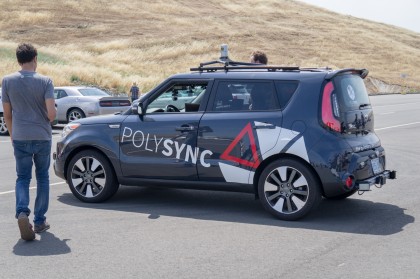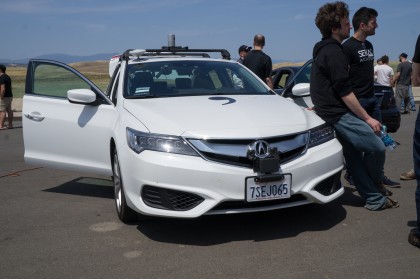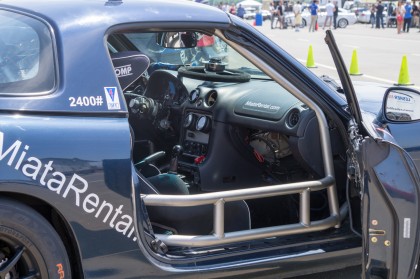Humans ride shotgun in world's first autonomous car track day

It's the Wild West for self-driving cars and it's never been more apparent than at the world's first autonomous car track day.
The two-day event took place at Thunderhill Raceway Park in Willows, California, three hours outside of San Francisco. It's a beautiful racetrack that rests between rolling hills that look like the Windows XP wallpaper. Companies working on autonomous car tech descended on the racetrack with a variety of different cars and tech.

The man who put together the event is Joshua Schachter, the creator of Delicious and Memepool. Schachter also worked briefly for Google, one of the big names missing from the track day roster.
But why have a bunch of autonomous cars better suited to a commute on the 405 show up to a high speed track day? "I wanted a place where companies could try out their technology in a controlled environment. It's a lot more forgiving to go off a track than it is to test in a city," said Schachter.

It wasn't your typical track day, with less of an emphasis on racing and setting lap records than it was about getting developers and journalists excited about the future of self-driving cars. There was a palpable sense of excitement and curiosity in the pits as different teams checked out each other's cars and discussed their strategies.

There was a Tesla Model S fitted with a huge array of different types of Light Detection and Ranging (LIDAR) sensors, set some hot laps after learning the course from a human driver.
The Tesla, along with a Lincoln MKZ and Kia Soul, were running Harbrick's PolySync self-driving car platform.
Sign up for breaking news, reviews, opinion, top tech deals, and more.
"The advantage of using a platform like PolySync is that it's hardware agnostic. If you want LIDAR data, you can get it without worrying about interfacing with specific sensors," said Lyle Johnson, Lead Field Application Engineer for Harbrick.

One of the teams that showed up was scrappy autonomous car startup, comma.ai, which was founded by prolific iPhone and PlayStation hacker, George Hotz. His goal is to get autonomous driving technology retrofitted into existing cars at a reasonable cost.

Comma.ai strapped its self-driving car tech to an Acura ILX and a Wheego LiFe, an all-electric city car that looks like a Smart fourtwo knockoff. Peeping into the trunk of the LiFe and you can see a gaming PC is the brains of the operation. It's rocking an Nvidia GeForce GTX 970 graphics card, so at least it's VR-ready.

AutonomouStuff/PolySync's Lincoln MKZ was one of the few cars that could actually run laps of Thunderhill West in fully autonomous mode. Its inputs were a bit jerky, like a beginner human driver, but it was still quite impressive watching it drive itself quickly. The only other car to drive autonomously on the track was comma.ai's white Acura ILX, which was super impressive as it used off-the-shelf hardware.
But the car that drew the most attention was the stunning Renovo Motors Coupe. The Coupe is based off of the Shelby Daytona Coupe, a car designed to take on Ferrari's 250 GTO at the 1964 Le Mans.

The Renovo Coupe is an all-electric supercar that blends 1960s styline with 2016 technology. Its electric motors put out an impressive 500 horsepower but a mind-blowing 1,000 lb-ft of torque. Renovo kept the Coupe's weight down by utilizing patent-pending lithium-ion technology that can charge rapidly.

Weighing in at 3,250 pounds, the Renovo Coupe is quite light for an all-electric supercar, but its battery pack is quite small to keep the weight down. The car only gets about 100 miles of range, and it spent most of the day charging in the pits. The range is a little disappointing for a car that costs $530,000, but its build quality is immaculate.

Velodyne was also at the track, testing and showing off the company's wide array of LIDAR sensors. You may know Velodyne more for its subwoofers and headphones, but the company's LIDAR sensors are actually used by most self-driving car teams. Even Google uses Velodyne's LIDAR sensor on its own self-driving cars.
Interestingly, Velodyne didn't bring their own car to test. Instead, they rented a race-prepped Spec-Miata to use for testing. With a human driver behind the wheel, Velodyne spent the day mapping out Thunderhill West to see just how accurate its sensors are.

The world's first autonomous car track day was unlike any track event I've been to. Just about every type of car was allowed on the track, from Renovo's $535,000 supercar to an electric go kart that looked like it was put together in someone's backyard shed. The go kart even broke down in the middle of the track and had to be towed back to the pits.

The autonomous driving teams were having a blast with their toys, on and off the track. There were several radio controlled cars and one even featured its own autonomous driving sensors.

As the day wound down, the engineers and press slowly migrated to the other side of Thunderhill where a superbike race was taking place. Everyone stood in awe, watching riders drag their knee on the pavement at over 90 miles per hour through turn one. They stood in silence as the superbikes howled toward redline down the front straight, watching riders get within inches of each other.

After a while, the teams drove back over the hill to the west side of the track to continue working on getting their self-driving cars. Perhaps one day, self-driving cars will be as quick as human drivers, but not today. Today, people are training the robots that will one day be their rivals on the track.
It's still the Wild West for autonomous cars but it won't always be. I'm excited for the future where we'll see humans and artificially intelligent cars racing flat out, egging each other to go faster, faster, faster.
